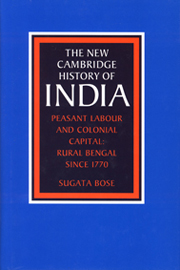2 - Commercialization and colonialism
Published online by Cambridge University Press: 28 March 2008
Summary
The response of agrarian society to demographic constraints and pressures to which it was subject was shaped, to a large extent, by the context of opportunities and risks emanating from wider economic systems increasingly based on capitalism and a colonial political order possessing its own agenda of economic priorities. The theme of ‘commercialization’, which has been such a favourite among agrarian historians of colonial India, must be recognized as simultaneously an economic and political process. The story that is to be told in this chapter is not simply one of expanding market forces which through dynamics of their own surely and steadily engulfed rural Bengal and redirected the thrust of its people's productive activities. It is equally a story of imperatives of states and political cultures which behind the facade of a rhetoric of free trade from the early nineteenth century onwards sought to impose and extend sets of monopolies. State-supported restriction and regulation of primary producers' options moulded the nature of their involvement in the marketplace. Politics did not, however, succeed in wholly reining in the laws of motion of economic arrangements over which it presided. Ever since the 1820s colonial and post-colonial states as much as peasants and agricultural labourers have been susceptible to the rhythms and fluctuations of wider economic trends.
These economic cycles and movements operating on a scale beyond the strict borders of agrarian society had significant income effects, both inflationary and deflationary, on the working peasantry. This alone makes it important to track the direction and strength of these trends as they bore down on the Bengal countryside.
Keywords
- Type
- Chapter
- Information
- Peasant Labour and Colonial CapitalRural Bengal since 1770, pp. 38 - 65Publisher: Cambridge University PressPrint publication year: 1993

